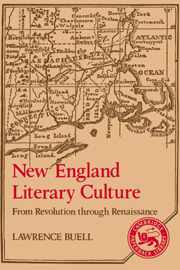Book contents
- Frontmatter
- Contents
- Acknowledgments
- Abbreviations of Frequently Cited Works
- PART I FOUR OVERVIEWS
- PART II THREE REPRESENTATIVE GENRES
- PART III REINVENTING PURITANISM: THE NEW ENGLAND HISTORICAL IMAGINATION
- Part IV NEW ENGLAND AS A COUNTRY OF THE IMAGINATION: THE SPIRIT OF PLACE
- 12 The Cultural Landscape in Regional Poetry and Prose
- 13 The Village as Icon
- 14 Lococentrism from Dwight to Thoreau
- 15 Comic Grotesque
- 16 Provincial Gothic: Hawthorne, Stoddard, and Others
- Postscript
- Appendix Vital Statistics: A Quantitative Analysis of Authorship as a Profession in New England
- Notes
- Index
13 - The Village as Icon
Published online by Cambridge University Press: 15 October 2009
- Frontmatter
- Contents
- Acknowledgments
- Abbreviations of Frequently Cited Works
- PART I FOUR OVERVIEWS
- PART II THREE REPRESENTATIVE GENRES
- PART III REINVENTING PURITANISM: THE NEW ENGLAND HISTORICAL IMAGINATION
- Part IV NEW ENGLAND AS A COUNTRY OF THE IMAGINATION: THE SPIRIT OF PLACE
- 12 The Cultural Landscape in Regional Poetry and Prose
- 13 The Village as Icon
- 14 Lococentrism from Dwight to Thoreau
- 15 Comic Grotesque
- 16 Provincial Gothic: Hawthorne, Stoddard, and Others
- Postscript
- Appendix Vital Statistics: A Quantitative Analysis of Authorship as a Profession in New England
- Notes
- Index
Summary
in every village, smil'd
The heav'n-inviting church, and every town
A world within itself …
Timothy Dwight, Greenfield Hill (1794)The charming thing – if that be the best way to take it – is that the scene is everywhere the same. … These communities stray so little from the type, that you often ask yourself by what sign or difference you know one from the other.
Henry James, The American Scene (1907)When New Englanders of our period pictured the cultural geography of their region in their mind's eye, the first thing they thought they saw was a patchwork of largely rural “towns” (i.e., townships) – small, selfcontained, preindustrial districts, agricultural or maritime, dotted with hamlets and with a central village as the social and economic hub. The following portrait, from Harriet Beecher Stowe's first important publication, is one of many:
Did you ever see the little village of Newbury, in New England? I dare say you never did; for it was just one of those out of the way places where nobody came unless they came on purpose: a green little hollow, wedged like a bird's nest between half a dozen high hills, that kept off the wind and kept out foreigners; so that the little place was as straitly sui generis as if there were not another in the world. […]
- Type
- Chapter
- Information
- New England Literary CultureFrom Revolution through Renaissance, pp. 304 - 318Publisher: Cambridge University PressPrint publication year: 1986



